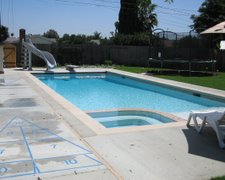Pump and Motor Efficient Sizing
This seems to be one of those topics that have a many different opinions. Before starting construction on my pool I spent time researching information on websites and still did not come up with any specific conclusions. One thing that most pool owners agree about is that pool circulation pumps use a lot of electricity (this seems to be one of the biggest complaints among new pool owners – I’ve lost the link to this forum topic).
I have to admit that I did not fully believe the information available, so I ended up with a 1.5 horsepower (HP) pump/motor for my primary circulation system (down from 2 HP that the contractor originally recommended). One of my reasons for keeping with a larger pump motor is that my solar heating system returns directly to the spa (allowing the spa bypass to be closed), which is separate from the pool return line where salt water chlorine generator is located (needing its own flow to operate properly). This feature keeps my spa warmer (5 to 15 degrees F) than the pool water that is pumped into the solar panels (more later).
This University of Florida, Pinellas County Extension, “Timely Topics” article titled “Energy Savings For Your Pool” does a good job of explaining the basics of hydraulics associated with the swimming pool circulation system. While the comparison table for pipe size and pump motor HP makes sense for single line systems, many newer pool circulation systems have multiple suction and return pipes, which increases the actual flow [e.g., my 1.5 HP system frequently pumps about 110 gallons per minute (gpm) because it draws from two or three 2-inch skimmer/vacuum lines and after the filter returns through 2.5-inch solar heating and 2-inch circulating lines].
Here is the first place I saw information about reducing the size of swimming pool pump motors. This guy is very rough around the edges but knows what he is talking about. “Sizing The Pool Pump” covers many of the basics particularly when looking at existing systems.
The chart in the “Swimming Pool Pump Energy Savings” article shows the approximate monthly electrical usage in kilowatt-hours (kWh) for various pump motor sizes and daily run times. Utilizing this information along with the other sites discussing circulation flow, it is possible to achieve an energy efficient circulating system. While this article touts the advantages of a two speed pump, I was not convinced about its benefit in my case because the low speeds are not capable of generating the pressure (water head) necessary for providing adequate water flow to the top of my solar panels.


1 comment:
Thanks for the information. Very useful, especially because my pump needs to be replaced very soon and I wanted to make sure, I did enough research before, I decided what to buy.
Post a Comment